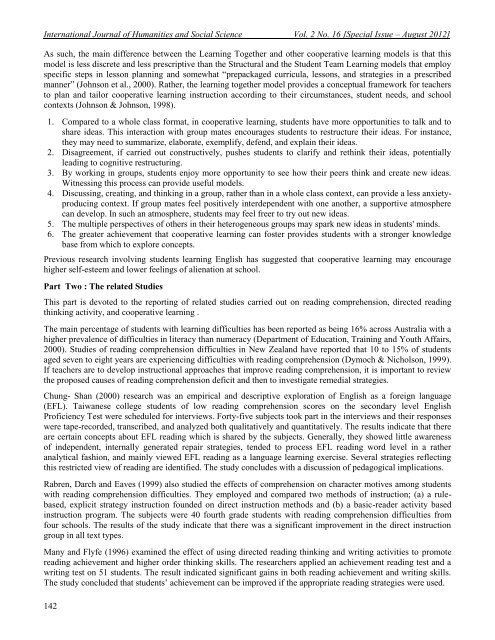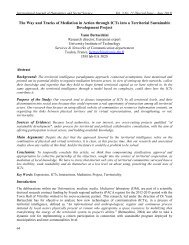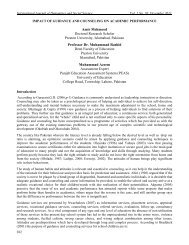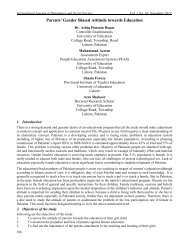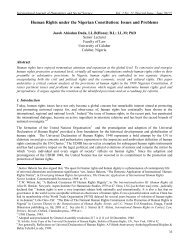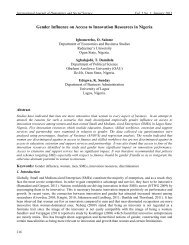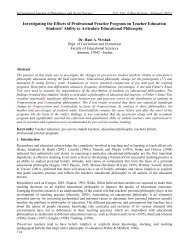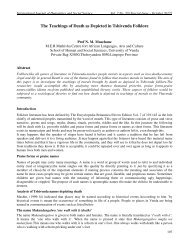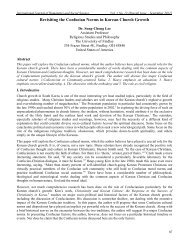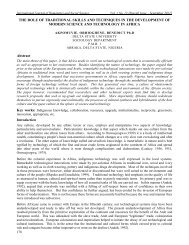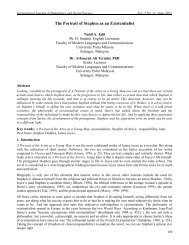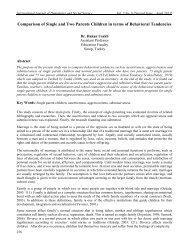The Effect of the Directed Reading Thinking Activity through ...
The Effect of the Directed Reading Thinking Activity through ...
The Effect of the Directed Reading Thinking Activity through ...
You also want an ePaper? Increase the reach of your titles
YUMPU automatically turns print PDFs into web optimized ePapers that Google loves.
International Journal <strong>of</strong> Humanities and Social Science Vol. 2 No. 16 [Special Issue – August 2012]<br />
As such, <strong>the</strong> main difference between <strong>the</strong> Learning Toge<strong>the</strong>r and o<strong>the</strong>r cooperative learning models is that this<br />
model is less discrete and less prescriptive than <strong>the</strong> Structural and <strong>the</strong> Student Team Learning models that employ<br />
specific steps in lesson planning and somewhat “prepackaged curricula, lessons, and strategies in a prescribed<br />
manner” (Johnson et al., 2000). Ra<strong>the</strong>r, <strong>the</strong> learning toge<strong>the</strong>r model provides a conceptual framework for teachers<br />
to plan and tailor cooperative learning instruction according to <strong>the</strong>ir circumstances, student needs, and school<br />
contexts (Johnson & Johnson, 1998).<br />
1. Compared to a whole class format, in cooperative learning, students have more opportunities to talk and to<br />
share ideas. This interaction with group mates encourages students to restructure <strong>the</strong>ir ideas. For instance,<br />
<strong>the</strong>y may need to summarize, elaborate, exemplify, defend, and explain <strong>the</strong>ir ideas.<br />
2. Disagreement, if carried out constructively, pushes students to clarify and rethink <strong>the</strong>ir ideas, potentially<br />
leading to cognitive restructuring.<br />
3. By working in groups, students enjoy more opportunity to see how <strong>the</strong>ir peers think and create new ideas.<br />
Witnessing this process can provide useful models.<br />
4. Discussing, creating, and thinking in a group, ra<strong>the</strong>r than in a whole class context, can provide a less anxietyproducing<br />
context. If group mates feel positively interdependent with one ano<strong>the</strong>r, a supportive atmosphere<br />
can develop. In such an atmosphere, students may feel freer to try out new ideas.<br />
5. <strong>The</strong> multiple perspectives <strong>of</strong> o<strong>the</strong>rs in <strong>the</strong>ir heterogeneous groups may spark new ideas in students' minds.<br />
6. <strong>The</strong> greater achievement that cooperative learning can foster provides students with a stronger knowledge<br />
base from which to explore concepts.<br />
Previous research involving students learning English has suggested that cooperative learning may encourage<br />
higher self-esteem and lower feelings <strong>of</strong> alienation at school.<br />
Part Two : <strong>The</strong> related Studies<br />
This part is devoted to <strong>the</strong> reporting <strong>of</strong> related studies carried out on reading comprehension, directed reading<br />
thinking activity, and cooperative learning .<br />
<strong>The</strong> main percentage <strong>of</strong> students with learning difficulties has been reported as being 16% across Australia with a<br />
higher prevalence <strong>of</strong> difficulties in literacy than numeracy (Department <strong>of</strong> Education, Training and Youth Affairs,<br />
2000). Studies <strong>of</strong> reading comprehension difficulties in New Zealand have reported that 10 to 15% <strong>of</strong> students<br />
aged seven to eight years are experiencing difficulties with reading comprehension (Dymoch & Nicholson, 1999).<br />
If teachers are to develop instructional approaches that improve reading comprehension, it is important to review<br />
<strong>the</strong> proposed causes <strong>of</strong> reading comprehension deficit and <strong>the</strong>n to investigate remedial strategies.<br />
Chung- Shan (2000) research was an empirical and descriptive exploration <strong>of</strong> English as a foreign language<br />
(EFL). Taiwanese college students <strong>of</strong> low reading comprehension scores on <strong>the</strong> secondary level English<br />
Pr<strong>of</strong>iciency Test were scheduled for interviews. Forty-five subjects took part in <strong>the</strong> interviews and <strong>the</strong>ir responses<br />
were tape-recorded, transcribed, and analyzed both qualitatively and quantitatively. <strong>The</strong> results indicate that <strong>the</strong>re<br />
are certain concepts about EFL reading which is shared by <strong>the</strong> subjects. Generally, <strong>the</strong>y showed little awareness<br />
<strong>of</strong> independent, internally generated repair strategies, tended to process EFL reading word level in a ra<strong>the</strong>r<br />
analytical fashion, and mainly viewed EFL reading as a language learning exercise. Several strategies reflecting<br />
this restricted view <strong>of</strong> reading are identified. <strong>The</strong> study concludes with a discussion <strong>of</strong> pedagogical implications.<br />
Rabren, Darch and Eaves (1999) also studied <strong>the</strong> effects <strong>of</strong> comprehension on character motives among students<br />
with reading comprehension difficulties. <strong>The</strong>y employed and compared two methods <strong>of</strong> instruction; (a) a rulebased,<br />
explicit strategy instruction founded on direct instruction methods and (b) a basic-reader activity based<br />
instruction program. <strong>The</strong> subjects were 40 fourth grade students with reading comprehension difficulties from<br />
four schools. <strong>The</strong> results <strong>of</strong> <strong>the</strong> study indicate that <strong>the</strong>re was a significant improvement in <strong>the</strong> direct instruction<br />
group in all text types.<br />
Many and Flyfe (1996) examined <strong>the</strong> effect <strong>of</strong> using directed reading thinking and writing activities to promote<br />
reading achievement and higher order thinking skills. <strong>The</strong> researchers applied an achievement reading test and a<br />
writing test on 51 students. <strong>The</strong> result indicated significant gains in both reading achievement and writing skills.<br />
<strong>The</strong> study concluded that students’ achievement can be improved if <strong>the</strong> appropriate reading strategies were used.<br />
142


